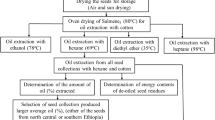Abstract
An enzymatic process optimization and a largescale plant trial for rapeseed oil degumming were carried out by a novel microbial lipase. Response surface methodology was used to obtain the desired data in the process optimization. Enzyme dosage, temperature, and pH were important determining factors affecting oil degumming. The optimal set of variables was an enzyme dosage of 39.6 mg/kg, a temperature of 48.3°C, and a pH of 4.9. The phosphorus content could be reduced to 3.1 mg/kg at the optimal levels of the tested factors. An enzymatic degumming plant trial was performed on a 400 tons/d oil production line. pH was found to play an important role in degumming performance. When the pH was 4.6–5.1, the corresponding phosphorus content of degummed rapeseed oil could be reduced to less than 10 mg/kg, which met the demands of the physical refining process.
Similar content being viewed by others
References
Čmoiik, J., and J. Pokornŷ, Physical Refining of Edible Oils, Eur. J. Lipid Sci. Technol. 102:472–486 (2000).
Carlson, K., Acid and Alkali Refining of Canola Oil, INFORM 4:272–281 (1993).
Denise, J., Fats Refining, in Oils & Fats Manual, edited by A. Karleskind, Lavoisier Publishing, Paris, 1996, Vol. 2, pp. 807–895.
Narayana, T., B. Kaimal, S.R. Vail, B.V. Surya, K. Rao, P.P. Chakrabarti, P. Vijayalakshmi, V. Kale, K. Narayana, P. Rani, O. Rajamma, P.S. Bhaskar, and T.C. Rao, Origin of Problems Encountered in Rice Bran Oil Processing, Eur. J. Lipid Sci. Technol. 104:203–211 (2002).
Gibon, V., and A. Tirtiaux, Removal of Gums and Waxes, INFORM 11:524–535 (2000).
Aalrust, E., W. Beyer, and H. Ottofrickenstein, Enzymatic Method for Reducing the Amount of Phosphorous-Containing Components in Vegetable and Animal Oils, Europe Patent 0,513,709 (1992).
Klaus, D., An Enzymatic Process for the Physical Refining of Seed Oils, Chem. Eng. Technol. 21:3–6 (1998).
Clausen K., Enzymatic Oil-Degumming by a Novel Microbial Phospholipase, Eur. J. Lipid Sci. Technol. 103:333–340 (2001).
Yang, J., B. Yang, and J. Meng, Soybean Oil Degumming by a Novel Phospholipase, Lecitase® Ultra, China Oils and Fats 28(10):10–13 (2003).
Yang, J., B. Yang, and Q. Li, Rapeseed Oil Degumming by Lecitase® Ultra, China Oils and Fats 28(12):31–34 (2003).
Yamada, K., Y. Ota, and H. Machida, A Modified Method for Lipase Activity Assay with Emulsified Olive Oil as Substrate, Nippon Nogei Kagaku Kaishi 36:860–863 (1962).
AOCS, Free Fatty Acids, Official Methods and Recommended Practices of the AOCS, 5th edn., AOCS Press, Champaign, 1997, Method Ca 5a-40.
Author information
Authors and Affiliations
Corresponding author
About this article
Cite this article
Yang, B., Wang, YH. & Yang, JG. Optimization of enzymatic degumming process for rapeseed oil. J Amer Oil Chem Soc 83, 653–658 (2006). https://doi.org/10.1007/s11746-006-1253-4
Received:
Accepted:
Issue Date:
DOI: https://doi.org/10.1007/s11746-006-1253-4




